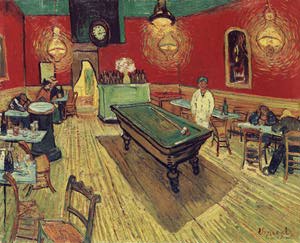

![]()
Vincent Van Gogh was only 37 years old when he shot himself in a wheatfield, and died two days later. Shortly before his death, he had painted the same field. The painting is as disturbing as his last letter to his brother Theo, which was found on his dead body.
"Well, my own work, I'm risking my life for it, and my reason has half foundered because of it - that's all right - but you are not among those dealers of men as far as I know, and you can still take sides I think, with humanity, well, what do you expect?"

The wheatfield represents his life as he saw it, full of turmoil, and uncertainty. The swirling lines of the sky, the rapid lines of the wheat, and the bold colours evoke a feeling of dread and disillusionment. The black lines depicting the crows circling this field are painted roughly with a knife to give a more harsh and brutal image. It is as if these crows are themselves the dark and menacing thoughts that must have plagued Van Gogh's mind in those last days.
As a man and as an artist, Van Gogh was totally ruled by his emotions. He was born to a family, where philanthropic ideals were important. His father was a Protestant Minister, and his mother nurtured his love for painting and drawing in his early childhood. Later in his life the poverty and misery that he saw and experienced in a poor mining community, for a short period as a lay preacher, overwhelmed him with nervous exhaustion, and yet influenced his art immensely.
Van Gogh's style and technique developed and changed at an incredible pace during the last three years of his life, and through his use of colour, lines, shapes and forms, he clearly expressed what he felt. Ironically, for a significant part of this period he was considered insane, and first locked up in isolation in a hospital, and then by his own consent, sent to an asylum.
In 1888 he painted, "Night Cafe - Interior", and he described his technique and vision in a letter to his brother.

"It was what they call here a night cafe... night prowlers can find a refuge here if they are unable to pay for a bed or if they are too drunk to be allowed anywhere.... I have tried to express the idea that the cafe is a place where one can ruin oneself, go mad or commit crimes. So I have tried, by contrasting soft red, blood red, the lees of wine, with soft Louis XV green and malachite...in an atmosphere like a devil's furnace, of pale sulphur, to express the powers of darkness in a low bar."
It is not enough to say that Van Gogh was a truly gifted artist. He was indeed a "true" artist. He was true to his emotions, and expressed them with such power and vibrancy, that to this day, it is rare to find an artist with his passion and boldness. His paintings were rapid, inspired, but also controlled in execution. It is not surprising that his vision and creative attitude has inspired a number of artists whom we now know collectively as Expressionists.
Katy Kianush
June 1998
SunflowersSunflowers: I have seen them everywhere; A rubái (quatrain) in English translation |
Copyright shall at all times remain vested in the Author. No part of the work shall be used, reproduced, stored in a retrieval system, or transmitted in any form or by any means electronic, mechanical, photocopying, recording or otherwise, without the Author's express written consent.
Copyright © 2004 K. Kianush, Art Arena